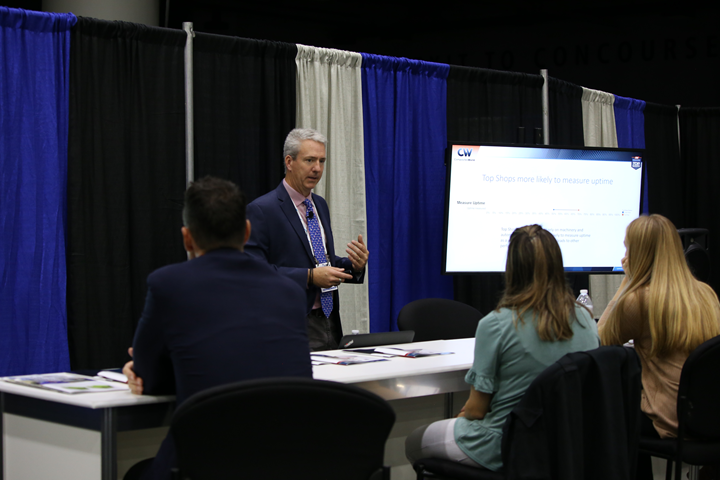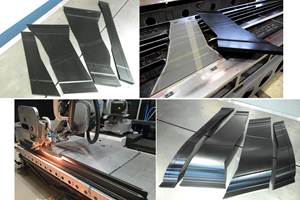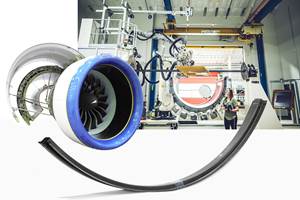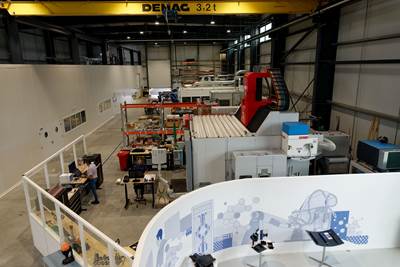
CW Editor-in-Chief Jeff Sloan presents at the 2021 Top Shops. Photo Credit: Gardner Business Media
CW has just completed its third year of running the CW Top Shops program. Top Shops is an annual operations benchmarking survey sent out to all of our subscribers who perform composites fabrication — which is most of you. The survey is in-depth and measures a variety of manufacturing metrics for the facility in which the respondent works, including scrap rate, order lead time, capacity utilization, on-time delivery rate, quality, capital spending, customer retention, sales per employee, sales growth, profit margin, inventory and more. The survey also asks, among other things, what industries are served by the facility, and what materials, processes, tooling types and inspection technology are used.
CW aggregates the responses each year, compares the results and generates a report for each respondent that shows how their facility compares to others in the survey. We also create a list of Top Shops — facilities that scored in the top 20% of all respondents. This year, Associate Editor Hannah Mason reported on CW’s 2021 Top Shops, including profiles of the composites fabricators that performed best (see “2021 CW Top Shops highlights strengths of top composites facilities”).
We have accumulated a fair amount of data through the CW Top Shops program in the last three years. In fact, we now have results from 627 survey responses, and these data tell us much about the habits and performance of Top Shops as compared to other shops — non-Top Shops, if you will. It’s worth exploring some of this information.
First, bear in mind that the composites manufacturing industry is relatively young, particularly compared to legacy materials like steel. Second, although machine-dependent composites manufacturing processes like pultrusion and filament winding have been in use for decades, the dominant processes have been spray-up (although less so anymore), wet layup and prepreg hand layup. Further, as the composites industry moves into new and expanding markets — like high-rate aerospace, automotive, advanced air mobility and hydrogen storage — demand will grow for automation to meet process control, quality and rate requirements. In fact, the Top Shops data reflect this transition.
Let’s start with the process question. CW Top Shops are significantly less likely than other shops to use hand layup and more likely to employ compression molding, filament winding, pultrusion or infusion. Further, this dependence on machinery also makes Top Shops more likely to measure equipment utilization and uptime. And, as you would expect, when you measure uptime, there is a subsequent desire to maximize uptime, and Top Shops have significantly higher uptime rates.
Next, let’s look at scale. CW Top Shops tend to operate facilities that are physically larger and they produce parts at a higher rate. They also tend to produce more different parts — more SKUs. However, Top Shops tend to employ fewer people than other shops; this is likely a byproduct of the fact that, as noted, Top Shops tend to rely less on manual labor and more on automation.
Perhaps the most telling data about Top Shops is their relationship with customers, and their ability to meet customer requirements and expectations. There are four metrics in particular where Top Shops really excel compared to other shops: order lead time, on-time delivery rate, active customers and customer retention rate. Consider, for example, that the median number of active customers for a Top Shop is 50, compared to 20 for other shops. Or that the customer retention rate is 98% for Top Shops and 92% for other shops. This is not to say that other shops fair poorly, but that Top Shops clearly have developed operational habits that provide strong customer service.
It’s not surprising, then, to learn that Top Shops are highly integrated with their customers. For example, Top Shops are much more likely to have supplier certifications, influence part design for manufacture, have access to customer forecasts and provide just-in-time delivery to customers. In short, Top Shops have deep and meaningful connections with their customers’ business.
We will continue to keep a close eye on the CW Top Shops data and look for more evidence of the composites industry’s transition toward industrialization. In the meantime, if you have not participated in CW Top Shops, but are interested in seeing how your operations compare to the rest of the industry, look for news of the launch of the 2022 CW Top Shops survey in early January 2022. Or, send me an email (jeff@compositesworld.com) and I will add you to the mailing list.
Related Content
Welding is not bonding
Discussion of the issues in our understanding of thermoplastic composite welded structures and certification of the latest materials and welding technologies for future airframes.
Read MoreRevisiting the OceanGate Titan disaster
A year has passed since the tragic loss of the Titan submersible that claimed the lives of five people. What lessons have been learned from the disaster?
Read More3D-printed CFRP tools for serial production of composite landing flaps
GKN Aerospace Munich and CEAD develop printed tooling with short and continuous fiber that reduces cost and increases sustainability for composites production.
Read MoreThe potential for thermoplastic composite nacelles
Collins Aerospace draws on global team, decades of experience to demonstrate large, curved AFP and welded structures for the next generation of aircraft.
Read MoreRead Next
2020 CW Top Shops recognizes top-performing facilities
CW's second annual Top Shops benchmarking survey helps composites fabricators put their operations into perspective and illuminates top-ranking facilities.
Read MorePlant tour: Daher Shap’in TechCenter and composites production plant, Saint-Aignan-de-Grandlieu, France
Co-located R&D and production advance OOA thermosets, thermoplastics, welding, recycling and digital technologies for faster processing and certification of lighter, more sustainable composites.
Read MoreAll-recycled, needle-punched nonwoven CFRP slashes carbon footprint of Formula 2 seat
Dallara and Tenowo collaborate to produce a race-ready Formula 2 seat using recycled carbon fiber, reducing CO2 emissions by 97.5% compared to virgin materials.
Read More























